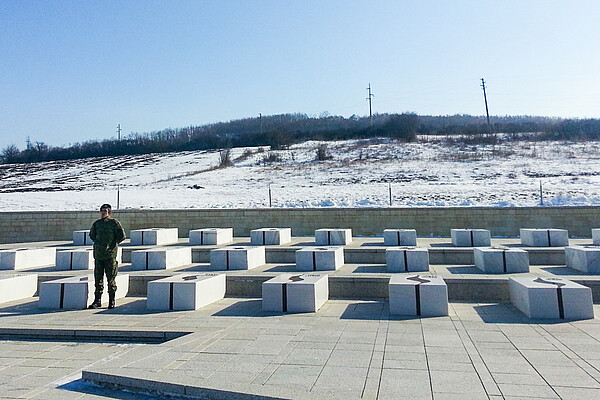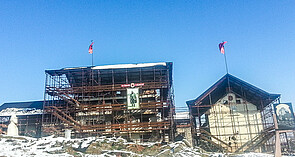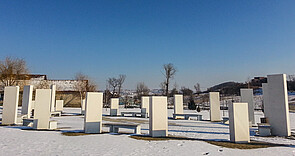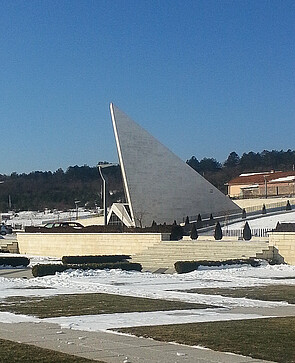25. Jul 2016 - DOI 10.25626/0052
Dr Vjollca Krasniqi is Assistant Professor at the Faculty of Philosophy, University of Prishtina, Kosovo.

This text offers a reading of the ways in which history and historical reasoning are integrated into memorialization practices in Kosovo, with a special focus on the Jashari family. It demonstrates that as a dominant part of collective memory in Kosovo, the Jashari Family Memorial is a site of discursive and memorial acts as well as performative cultural practices in the service of the nation. It is a staple of collective memory and of the ways in which the past is represented and how its meaning is maintained through commemoration. The memorial has assumed the centre stage in the projection of the history of the Kosovo War; it has been made a new epic, serving as a source of state legitimacy and as a discourse to solidify the nation. The memorial is a place imbued with history, memory and organic national relations. The memory of the Jashari family is not represented as one brutal incident in the history of war; rather, it is a vision of the nation’s imagined past and history that renders war impossible to forget.
Adem Jashari is considered one of the founders of the Kosovo Liberation Army (KLA) and the leader of the armed resistance against the Serbian president Slobodan Milošević and his regime. He was born in the village of Prekaz in the Drenica region of central Kosovo which became the stronghold of the KLA. As a rural area, it was poor, having been one of the most neglected regions of the former socialist Yugoslavia. The Jashari family was an extended family consisting of three generations: the parents, their three sons and the sons’ respective families. The institution of the extended family[1] was common in the rural areas of Kosovo as economic conditions made it difficult for the nuclear family to be self-reliant. Headed by the oldest male, the Jashari family was patrilineal in structure; a structure in which traditional gender roles prevail and the lineage of the family is carried out through marriage, male ownership and inheritance. Today, the family structure has changed, resulting in families that are generally smaller in size. However, the family remains a symbol of struggle for economic sustenance and gendered relations of power. Indeed, family continues to bear the responsibility for the well-being and security of its members.[2]
Adem Jashari belonged, as noted, to the KLA’s armed resistance, which conducted a guerrilla-type warfare through the use of hit-and-run tactics. Adem’s insurgency and KLA’s organizing did not go unnoticed by the Milošević regime. He was on a Serbian 'most-wanted' list, but repeated attempts to apprehend him proved unsuccessful. On 22 January 1998, the family compound was attacked but suffered no casualties since all the family members had been hiding in the woods.[3] However, in the early morning of 5 March 1998, the Serbian forces went after Adem again. This time, Adem and his family fought back. After three days of continuous shelling, Adem and more than fifty members of his extended family (including women, children, and the elderly) were killed; only one survived. Besarta, Adem’s niece, who was ten years old at the time, was the only one to live through the attack.
The killing of the Jashari family sparked widespread protests in Kosovo and among the Albanian diaspora. It not only led to heightened solidarity among the Albanians, but it also drew the attention of the international community to the conflict. It prompted the Western Powers, who were members of the International Contact Group (for the Balkans), to impose limited sanctions on the Federal Republic of Yugoslavia.[4] According to Kosovo’s Albanian newspaper Koha Ditore, over 500 000 people in Kosovo joined the protests against the Serbian military attack on the Jashari family.[5] Ibrahim Rugova, the President of the then unrecognized Republic of Kosovo, declared two days of mourning.[6] The funeral of the Jashari family was attended by a large number of Kosovo Albanians, and because the Serbian security forces kept their distance, it managed to pass peacefully, without incident.
As historian James Pettifer has pointed out, funerals play an important role in the development of many insurgent movements: they provide an opportunity for popular mobilisation and political participation,[7] as was the case in Kosovo with the Jashari family funeral. The armed resistance of the Jashari family was framed as a sacrifice for the nation––the sacrifice of Adem and his family. Adem himself was immortalised as “the legendary commander."[8] Indeed, the sacrifice was to be understood as a gesture of heroism through physical sacrifice and military struggle.[9] Thus, it had a deeper meaning and should be seen as part of the struggle for political change, the impact of which was to be judged by the results. The killing of the Jashari family not only played a key role in mobilising the Kosovo-Albanian resistance against the Serbian oppressors, but was also crucial in their fight for independence after the Kosovo War. It was made the dominant trope in national ideologies, in the Kosovo War narratives and in state-building practices.
In 2005, the Assembly of Kosovo adopted the law on the Memorial Complex "Adem Jashari." This law turned the Jashari family compound into a site "of ontological, anthropological, historical, cultural and civic significance for the wider Albanian nation"[10] –-in short, for all ethnic Albanians. Moreover, as part of the institutionalisation of wartime memory in general, and the Jashari family in particular, the government began sponsoring an annual commemorative three-day event, Epopeja e UÇK (The Epopee of KLA), on 5–7 March to mark the armed resistance of the Jashari family on those dates in 1998.[11] The Jashari Family Memorial has become the most popular "political tourist" site in Kosovo. The number of visitors has already passed the eleven million mark.[12]
The memorial does not stand as an abstraction of war, nor as an imagination of it; rather, it is meant to represent the architecture of the nation. From a holistic perspective, the memorial is a site to be viewed outdoors. It is free-entry to enable public commemoration during The Epopee of KLA ceremony. The aesthetic language of the memorial is grounded in a threefold symbolism, reflecting its three components: (1) the family compound; (2) the cemetery; and (3) the museum. The symbolic meaning of the number "three" in the memorial’s architecture denotes the three attacks on the Jashari family: first in 1992, then in January 1998, and finally in March 1998. It further marks their three-day armed resistance and speaks to the fact that there were three Jashari brothers and that Adem had three sons. This figuration embodies the particularity of the family by reworking the universality of the patriarchal family and the nation as an extension of it.
As Image 1 shows, the Jashari family compound has been preserved as it was after the attack in 1998. These houses that have been mutilated by shells leave a strange, eerie feeling of violence and destruction. The structures stand supported by scaffolding to preserve the history of the attack and its immediate aftermath. The objects on display include a tractor and various pieces of furniture that were left in the houses, while the walls remain covered with bullet holes. On the one hand, it is a reminder of how people lived and of human potential; on the other hand, it is a manifestation of human destruction. Two Albanian flags adorn the Oda (the traditional premises designated for men and male guests) and Shpija, the family home.[13] On the left side of the compound is a statue of Adem in military uniform; on the right is a plaque depicting Adem Jashari himself, and his brother Hamza. In the Shpija, there is a large banner with Adem's picture and an inscription that reads, "Ai është i gjallë" ("He is alive") with the KLA emblem interjected in the middle of the sentence. In this inscription, Adem Jashari and the KLA are posited as living subjects and in symbiosis.
Outside the Jashari family compound itself is the memorial which includes the graves of the extended Jashari family who were killed in the attack. Beginning at the compound, there is a maroon-coloured path, symbolizing blood, which twists and winds all the way to the graves of the Jashari family, connecting the cemetery with the houses. Two members of the Kosovo Security Force (KSF) keep a vigil on both sides of Adem's grave. The Albanian flag waves in the air, accompanying the KSF members in their vigil. In this commemorative fervour, vigilance is rendered a must so that history will not wither the memory.[14]
Both death and life are intensely present in the memorial. Between the compound and the cemetery, there are three rounds of flower beds, symbolizing the three sons of Adem Jashari (see Image 3); this is contrasted with the green squares in the "Public Square" which represent the renewal of the Jashari family. Paralleling this is the "Square of Reconciliation" where twenty-four blocks, each of a different size, stand to commemorate the blood feud reconciliation movement in 1990.
In the late 1980s, blood feuds threatened the lives of 17 000 men in Kosovo, confining them to their homes. On 1 May 1990—in a place called Verrat e Llukës in the Deçan plain of western Kosovo—a large public gathering of Albanian families from Kosovo, Albania, Macedonia, Montenegro and the diaspora joined in the public staging of blood feud reconciliation.[15] The inclusion of the commemoration of this resolution in the memorial is deliberate. The connecting thread is that the blood feud reconciliation, with Adem's participation, was larger than vengeance, even when customary law and ideals of manhood and family honour were seemingly breached when the nation was exposed to the larger threat of annihilation by the Milošević regime. Indeed, the reconciliation process set the stage for forging national unity and fraternity. As the 'father' of the blood feud reconciliation, the highly revered intellectual Anton Çeta promoted reconciliation by saying "isn’t it important […] to have the population […] united?"[16] Because lineage is the 'artery' of the Jashari Family Memorial, it is thus paralleled with the blood feud reconciliation in order to reinforce the idea of national belonging––a national belonging that presupposes national unity.
Another part of the Jashari Family Memorial is the museum: a three-sided building mimicking a pyramid. This imitation is metaphorical, having a deep and esoteric meaning. The symbol of the pyramid constitutes the spiritual realm of the nation and how nation comes into being. But it also serves a political purpose, producing an optimistic view of the nation's future. The pyramid builds on the concept of the “three”, like the three brothers, three battles, and the three days of armed resistance. The pyramid can be read as a symbol of national harmony and unity. As a trope, the pyramid is not a mere artefact of commemoration; instead, it comes to represent the struggle of generations. It is a symbol of male power and the patriarchal ordering of the nation. Further, the building blocks of the pyramid represent what the nation has already achieved: the armed resistance of the Jashari family and the KLA, the resolution of blood feuds, and its political independence. Hence, the pyramid solidifies the narratives of the national struggle for statehood. The blocks that we assume make up the pyramid, as depicted in one of the wall paintings in the museum, bring into one canon the core historical narratives from Skanderbeg[17] the Prizren League,[18] the Jashari family and the KLA armed resistance, and the Newborn monument in Prishtina, symbolizing the independence of Kosovo. These narratives are meant to build a particular linear rendition of the national experience through the interplay between history and memory.
The Jashari Family Memorial mimics the framing of the Kosovo War through the narrative of the collective struggle of Kosovo Albanians against Serbian state oppression and violence. Yet, this is not to state that national discourses are devoid of tension and contested legacies. The most prominent one is the division over the two competing nationalist narratives between Ibrahim Rugova’s peaceful resistance and the KLA’s armed resistance. But the connecting thread here is that of a just war, the struggle for liberation, and freedom and independence from the Milošević regime. Moreover, the marble gravestones in the blood feud reconciliation monument, as well as in the façade of the museum, are deliberately white in order to represent purity, innocence and wholeness.
In retrospect, the meaning conveyed by the Jashari Family Memorial is that of a background for staging the nation. It is a choreographed nationalist geography with the soul laid out in the open. The memorial is first and foremost a reminder of the Jashari family as the nucleus of the KLA and its armed resistance; it is a place of memory where one actively remembers the Kosovo War—not necessarily "the tragedy" of the Jashari family, but the heroism embodied in the nation's wartime resistance. Thus, instead of being a site of private mourning, the memorial is meant to promote national public mourning. By commemorating the Jashari family, the state and the public commemorates the collective struggle of the nation. This type of commemoration serves to legitimise state power by valorising the Jashari family and their armed struggle.
Memorialisation processes in Kosovo generally focus on commemorating heroes and martyrs. But it is the Jashari Family Memorial that has assumed a dominant role in the collective memory of Kosovo Albanians. The monumentalization of the site testifies to a kind of intervention aimed at putting identity "in its place". Moreover, the memorial has become part of historical memory; it is included in history textbooks and serves as a pedagogical venue for organised school visits. In short, Adem Jashari is not only commemorated as a hero, but the Jashari family has also become an ethno-national narrative—a new epic and foundational myth. This role was carved out by the elites (ex-KLA soldiers turned politicians) to suit their political goals in post-war nation- and state-building processes. Yet, memorialisation practices in Kosovo are not unitary, but rather plural with the memories of different groups competing for a place in the landscape of collective memory––especially those who promoted a peaceful political engagement, and those who opted for the armed struggle in the fight for independence.
The Jashari Family Memorial is an extension of the "realm of memory", to use Pierre Nora's notion.[19] As a regime of memory, it fosters a duty to remember. This commemoration symbol stands as a guardian against the danger of time, i.e. forgetting. Hence, memorialisation and commemoration are a constant reminder of the threat of oblivion; yet at the same time, they require a constant remembrance of the past in the present. The memorial represents an affirmation of place, family and nation; indeed, it is a site of temporal unfolding of the nation’s history at play. As Paul Ricouer has put it, "temporality constitutes the existential precondition for the reference of memory and of history to the past."[20] Thus, remembering is a transient experience because memory necessarily involves time. The Jashari Family Memorial and its commemorations stand against the temporality of memory and the risk of forgetting. In this script, the nation, just like time, is represented as uninterrupted and linear. Memory is projected as redemption of the nation’s time past. Hence, the need to remember is an ever-present possibility against forgetting.
In the nexus between memory and history, memory is seen as absolute, while history is seen as a representation of the past that is relative and potentially universal. And as Nora has argued, "the memory-nation was, thus, the last incarnation of the unification of memory and history."[21] This resonates well with the Jashari Family Memorial where "the memory-nation, memory-history […] covers the same space of meaning as memory."[22] It is only against this background that one can grasp the meaning of the memorial as a site of the reconciliation of time and temporality. As an intersection of memory-history, the Memorial advances the "imagining of the nation" and the construction of national identity. And in this epistemic synergy between memory and history, the place of memory does not only service memory, but also history.[23] In short, as a political project, the Memorial is meant to establish organic links between memory, history, and the nation as a way of cementing their unbroken shared meanings.[24]
Vjollca Krasniqi: Between History and Memory: The Jashari Family Memorial in Prekaz (Kosovo). In: Cultures of History Forum (25.07.2016), DOI: 10.25626/0052.
Copyright (c) 2016 by Imre Kertész Kolleg, all rights reserved. This work may be copied and redistributed for non-commercial, educational purposes, if permission is granted by the copyright holders. For permission please contact the editors.




Get this article as PDF download (including pictures).